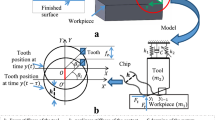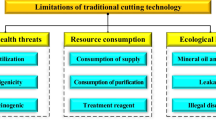Abstract
The grinding process is one of the most important and widely used machining processes to achieve the desired surface quality and dimensional accuracy. Due to the stochastic nature of the grinding process and process conditions, the instantaneous micro-mechanisms between each grain and the workpiece are momentarily changing and are different from the other grains. Thus, the resultant normal and tangential grinding forces could be obtained by making the vector superposition of the instantaneous forces resulting from the contact of each grain and the workpiece. Previous studies in grinding forces have largely ignored the effects of micro-mechanisms of grain-workpiece in the grinding forces. On the other hand, most of these models are performed to predict grinding forces in the dry state that only can predict the maximal grinding forces based on the maximal value of undeformed chip thickness. In this research, a comprehensive model was used to analyze and predict the grinding forces both under dry conditions and in the presence of grinding fluid. In this research, the instantaneous undeformed chip thickness was calculated by a new method to determine the grinding forces at better accuracy. The proposed model can predict the components of normal and tangential grinding forces (including sliding, plowing, and cutting) based on the instantaneous undeformed chip thickness resulting from the kinematic analysis of abrasive grain trajectory and micro-mechanisms of cutting between abrasive grain and workpiece. By this method, the grinding forces were calculated more accurately than previous analytical models. In addition, a 2D slip line model was employed to separate dry and lubricated stages along with friction coefficient estimation for every single grain instantaneously. By this approach, the normal and tangential grinding forces could be predictable without the need for constant coefficients and additional experimental tests in both dry and lubricated stages. According to the proposed method, the effects of grinding parameters on each component of grinding forces were analyzed in both dry and lubricated grinding. The proposed model can also increase the accuracy of modeling in other grinding situations such as wheel loading issue, surface topography analysis, heat analysis, and specific grinding energy. In the end, experimental tests were performed to validate the theoretical model.
Graphic abstract





















Similar content being viewed by others
References
Zhang Y, Li C, Ji H et al (2017) Analysis of grinding mechanics and improved predictive force model based on material-removal and plastic-stacking mechanisms. Int J Mach Tools Manuf 122:81–97. https://doi.org/10.1016/j.ijmachtools.2017.06.002
Werner G (1978) Influence of work material on grinding forces. Gen Assem CIRP, 28th. Manuf Technol 27:243–248
Tönshoff HK, Peters J, Inasaki I, Paul T (1992) Modelling and simulation of grinding processes. CIRP Ann - Manuf Technol 41:677–688. https://doi.org/10.1016/S0007-8506(07)63254-5
Mishra VK, Salonitis K (2013) Empirical estimation of grinding specific forces and energy based on a modified Werner grinding model. Procedia CIRP 8:287–292. https://doi.org/10.1016/j.procir.2013.06.104
Fuh KH, Bin WS (1997) Force modeling and forecasting in creep feed grinding using improved BP neural network. Int J Mach Tools Manuf 37:1167–1178. https://doi.org/10.1016/S0890-6955(96)00012-0
Liu Q, Chen X, Wang Y, Gindy N (2008) Empirical modelling of grinding force based on multivariate analysis. J Mater Process Technol 203:420–430. https://doi.org/10.1016/j.jmatprotec.2007.10.058
Guo M, Li B, Ding Z, Liang SY (2016) Empirical modeling of dynamic grinding force based on process analysis. Int J Adv Manuf Technol 86:3395–3405. https://doi.org/10.1007/s00170-016-8465-z
Malkin S, Guo C (2008) Grinding technology: theory and application of machining with abrasives. Industrial Press Inc.
Lichun L, Jizai F, Peklenik J (1980) A study of grinding force mathematical model. CIRP Ann - Manuf Technol 29:245–249. https://doi.org/10.1016/S0007-8506(07)61330-4
Younis M, Sadek MM, El-Wardani T (1987) A new approach to development of a grinding force model. J Manuf Sci Eng Trans ASME 109:306–313. https://doi.org/10.1115/1.3187133
Patnaik Durgumahanti US, Singh V, Venkateswara Rao P (2010) A new model for grinding force prediction and analysis. Int J Mach Tools Manuf 50:231–240. https://doi.org/10.1016/j.ijmachtools.2009.12.004
Tang J, Du J, Chen Y (2009) Modeling and experimental study of grinding forces in surface grinding. J Mater Process Technol 209:2847–2854. https://doi.org/10.1016/j.jmatprotec.2008.06.036
Yao C, Wang T, Xiao W et al (2014) Experimental study on grinding force and grinding temperature of Aermet 100 steel in surface grinding. J Mater Process Technol 214:2191–2199
Hecker RL, Ramoneda IM, Liang SY (2003) Analysis of wheel topography and grit force for grinding process modeling. Trans North Am Manuf Res Inst SME 31:281–288
Cao J, Wu Y, Li J, Zhang Q (2015) A grinding force model for ultrasonic assisted internal grinding (UAIG) of SiC ceramics. Int J Adv Manuf Technol 81:875–885. https://doi.org/10.1007/s00170-015-7282-0
Azizi A, Adibi H, Rezaei SM, Baseri H (2011) Modeling of specific grinding energy based on wheel topography. In: Advanced Materials Research. Trans Tech Publ, pp 72–78
Chang HC, Wang JJJ (2008) A stochastic grinding force model considering random grit distribution. Int J Mach Tools Manuf 48:1335–1344. https://doi.org/10.1016/j.ijmachtools.2008.05.012
Li HN, Yu TB, Wang ZX et al (2017) Detailed modeling of cutting forces in grinding process considering variable stages of grain-workpiece micro interactions. Int J Mech Sci 126:319–339. https://doi.org/10.1016/j.ijmecsci.2016.11.016
ma Y, yang J, li B, lu J, (2017) An analytical model of grinding force based on time-varying dynamic behavior. Int J Adv Manuf Technol 89:2883–2891. https://doi.org/10.1007/s00170-016-9751-5
Kadivar M, Azarhoushang B, Krajnik P (2021) Modeling of micro-grinding forces considering dressing parameters and tool deflection. Precis Eng 67:269–281. https://doi.org/10.1016/j.precisioneng.2020.10.004
Zhang Y, Li C, Jia D, et al (2016) Experimental study on the effect of nanoparticle concentration on the lubricating property of nanofluids for MQL grinding of Ni-based alloy. Elsevier B.V.
Guo S, Li C, Zhang Y et al (2017) Experimental evaluation of the lubrication performance of mixtures of castor oil with other vegetable oils in MQL grinding of nickel-based alloy. J Clean Prod 140:1060–1076. https://doi.org/10.1016/j.jclepro.2016.10.073
Li B, Li C, Zhang Y et al (2017) Heat transfer performance of MQL grinding with different nanofluids for Ni-based alloys using vegetable oil. J Clean Prod 154:1–11. https://doi.org/10.1016/j.jclepro.2017.03.213
Gao T, Li C, Yang M et al (2021) Mechanics analysis and predictive force models for the single-diamond grain grinding of carbon fiber reinforced polymers using CNT nano-lubricant. J Mater Process Technol 290:116976. https://doi.org/10.1016/j.jmatprotec.2020.116976
Yang M, Li C, Zhang Y et al (2019) Effect of friction coefficient on chip thickness models in ductile-regime grinding of zirconia ceramics. Int J Adv Manuf Technol 102:2617–2632. https://doi.org/10.1007/s00170-019-03367-0
Yang M, Li C, Zhang Y et al (2019) Predictive model for minimum chip thickness and size effect in single diamond grain grinding of zirconia ceramics under different lubricating conditions. Ceram Int 45:14908–14920. https://doi.org/10.1016/j.ceramint.2019.04.226
Dai C, Yin Z, Ding W, Zhu Y (2019) Grinding force and energy modeling of textured monolayer CBN wheels considering undeformed chip thickness nonuniformity. Int J Mech Sci 157–158:221–230. https://doi.org/10.1016/j.ijmecsci.2019.04.046
Jamshidi H, Budak E (2020) An analytical grinding force model based on individual grit interaction. J Mater Process Technol 283:116700. https://doi.org/10.1016/j.jmatprotec.2020.116700
Li M, Yin J, Che L et al (2021) Influence of alumina abrasive tool wear on ground surface characteristics and corrosion properties of K444 nickel-based superalloy. Chinese J Aeronaut. https://doi.org/10.1016/j.cja.2021.06.008
Zhao B, Ding W, Xiao G et al (2021) Effects of open pores on grinding performance of porous metal-bonded aggregated cBN wheels during grinding Ti–6Al–4V alloys. Ceram Int 47:31311–31318. https://doi.org/10.1016/j.ceramint.2021.08.004
Cao Y, Zhu Y, Ding W et al (2021) Vibration coupling effects and machining behavior of ultrasonic vibration plate device for creep-feed grinding of Inconel 718 nickel-based superalloy. Chinese J Aeronaut. https://doi.org/10.1016/j.cja.2020.12.039
Zhang Z, Huo Y, Guo D (2013) A model for nanogrinding based on direct evidence of ground chips of silicon wafers. Sci China Technol Sci 56:2099–2108. https://doi.org/10.1007/s11431-013-5286-2
Zhang Z, Song Y, Xu C, Guo D (2012) A novel model for undeformed nanometer chips of soft-brittle HgCdTe films induced by ultrafine diamond grits. Scr Mater 67:197–200. https://doi.org/10.1016/j.scriptamat.2012.04.017
Zhang Z, Huo F, Zhang X, Guo D (2012) Fabrication and size prediction of crystalline nanoparticles of silicon induced by nanogrinding with ultrafine diamond grits. Scr Mater 67:657–660. https://doi.org/10.1016/j.scriptamat.2012.07.016
Zhang Z, Wang B, Kang R et al (2015) Changes in surface layer of silicon wafers from diamond scratching. CIRP Ann - Manuf Technol 64:349–352. https://doi.org/10.1016/j.cirp.2015.04.005
Zhang Z, Guo D, Wang B et al (2015) A novel approach of high speed scratching on silicon wafers at nanoscale depths of cut. Sci Rep 5:1–9. https://doi.org/10.1038/srep16395
Zhang Z, Cui J, Wang B et al (2017) A novel approach of mechanical chemical grinding. J Alloys Compd 726:514–524. https://doi.org/10.1016/j.jallcom.2017.08.024
Zhang Z, Huang S, Wang S et al (2017) A novel approach of high-performance grinding using developed diamond wheels. Int J Adv Manuf Technol 91:3315–3326. https://doi.org/10.1007/s00170-017-0037-3
Wang B, Zhang Z, Chang K et al (2018) New deformation-induced nanostructure in silicon. Nano Lett 18:4611–4617. https://doi.org/10.1021/acs.nanolett.8b01910
Rowe WB (2013) Principles of modern grinding technology. William Andrew
van der Linde G (2011) Predicting galling behaviour in deep drawing processes
Adibi H, Rezaei SM, Sarhan AAD (2013) Analytical modeling of grinding wheel loading phenomena. Int J Adv Manuf Technol 68:473–485. https://doi.org/10.1007/s00170-013-4745-z
Wei J, Wang H, Lin B et al (2019) A force model in single grain grinding of long fiber reinforced woven composite. Int J Adv Manuf Technol 100:541–552. https://doi.org/10.1007/s00170-018-2719-x
Onishi T (2018) Grinding force and grinding heat: thermal deformation of a workpiece and compensation system. Toraibarojisuto/Journal Japanese Soc Tribol 63:145–152. https://doi.org/10.18914/tribologist.63.03_145
Challen JM, Oxley PLB (1979) An explanation of the different regimes of friction and wear using asperity deformation models. Wear 53:229–243. https://doi.org/10.1016/0043-1648(79)90080-2
Liu Y, Warkentin A, Bauer R, Gong Y (2013) Investigation of different grain shapes and dressing to predict surface roughness in grinding using kinematic simulations. Precis Eng 37:758–764. https://doi.org/10.1016/j.precisioneng.2013.02.009
Hou ZB, Komanduri R (2003) On the mechanics of the grinding process—Part I. Stochastic nature of the grinding process. Int J Mach Tools Manuf 43:1579–1593. https://doi.org/10.1016/S0890-6955(03)00186-X
M Kang L Zhang W Tang (2020) Study on three-dimensional topography modeling of the grinding wheel with image processing techniques. Int J Mech Sci 167 https://doi.org/10.1016/j.ijmecsci.2019.105241
Sun Y, Su ZP, Gong YD et al (2020) An experimental and numerical study of micro-grinding force and performance of sapphire using novel structured micro abrasive tool. Int J Mech Sci 181 https://doi.org/10.1016/j.ijmecsci.2020.105741
Bowden FP, Bowden FP, Tabor D (2001) The friction and lubrication of solids. Oxford University Press
Xie Y, Williams JA (1996) The prediction of friction and wear when a soft surface slides against a harder rough surface. Wear 196:21–34. https://doi.org/10.1016/0043-1648(95)06830-9
Winter M, Thiede S, Herrmann C (2015) Influence of the cutting fluid on process energy demand and surface roughness in grinding—a technological, environmental and economic examination. Int J Adv Manuf Technol 77:2005–2017. https://doi.org/10.1007/s00170-014-6557-1
van der Heide E, Schipper DJ (2003) Galling initiation due to frictional heating. Wear 254:1127–1133. https://doi.org/10.1016/S0043-1648(03)00324-7
Hokkirigawa K, Kato K (1988) An experimental and theoretical investigation of ploughing, cutting and wedge formation during abrasive wear. Tribol Int 21:51–57. https://doi.org/10.1016/0301-679X(88)90128-4
Johnson KL, Johnson KL (1987) Contact mechanics. Cambridge University Press
Jourani A (2015) Modelling of ploughing-cutting transition regime during abrasive manufacturing process. Int J Mechatronics Manuf Syst 8:19–32. https://doi.org/10.1504/IJMMS.2015.071664
Dai CW, Yu TY, Ding WF et al (2019) Single diamond grain cutting-edges morphology effect on grinding mechanism of Inconel 718. Precis Eng 55:119–126. https://doi.org/10.1016/j.precisioneng.2018.08.017
Author information
Authors and Affiliations
Contributions
HA conceived of the presented idea. FJ developed the theory and performed the computations. HA and AR verified the analytical methods. HA and AR encouraged FJ to investigate and supervised the findings of this work. All authors discussed the results and contributed to the final manuscript.
Corresponding author
Ethics declarations
Conflict of interest
The authors declare no competing interests.
Additional information
Publisher's Note
Springer Nature remains neutral with regard to jurisdictional claims in published maps and institutional affiliations.
Highlights
• A comprehensive analytical model is proposed to predict grinding forces for ductile materials.
• The model is established based on the superposition of grinding forces caused by abrasives in the contact zone with various micro-interaction types (sliding, plowing, and cutting).
• A novel method is used to calculate instantaneous undeformed chip thickness for every individual grain.
• The model can predict grinding forces in both dry and lubricated states with acceptable accuracy.
Rights and permissions
About this article
Cite this article
Adibi, H., Jamaati, F. & Rahimi, A. Analytical simulation of grinding forces based on the micro-mechanisms of cutting between grain-workpiece. Int J Adv Manuf Technol 119, 4781–4801 (2022). https://doi.org/10.1007/s00170-021-08280-z
Received:
Accepted:
Published:
Issue Date:
DOI: https://doi.org/10.1007/s00170-021-08280-z




